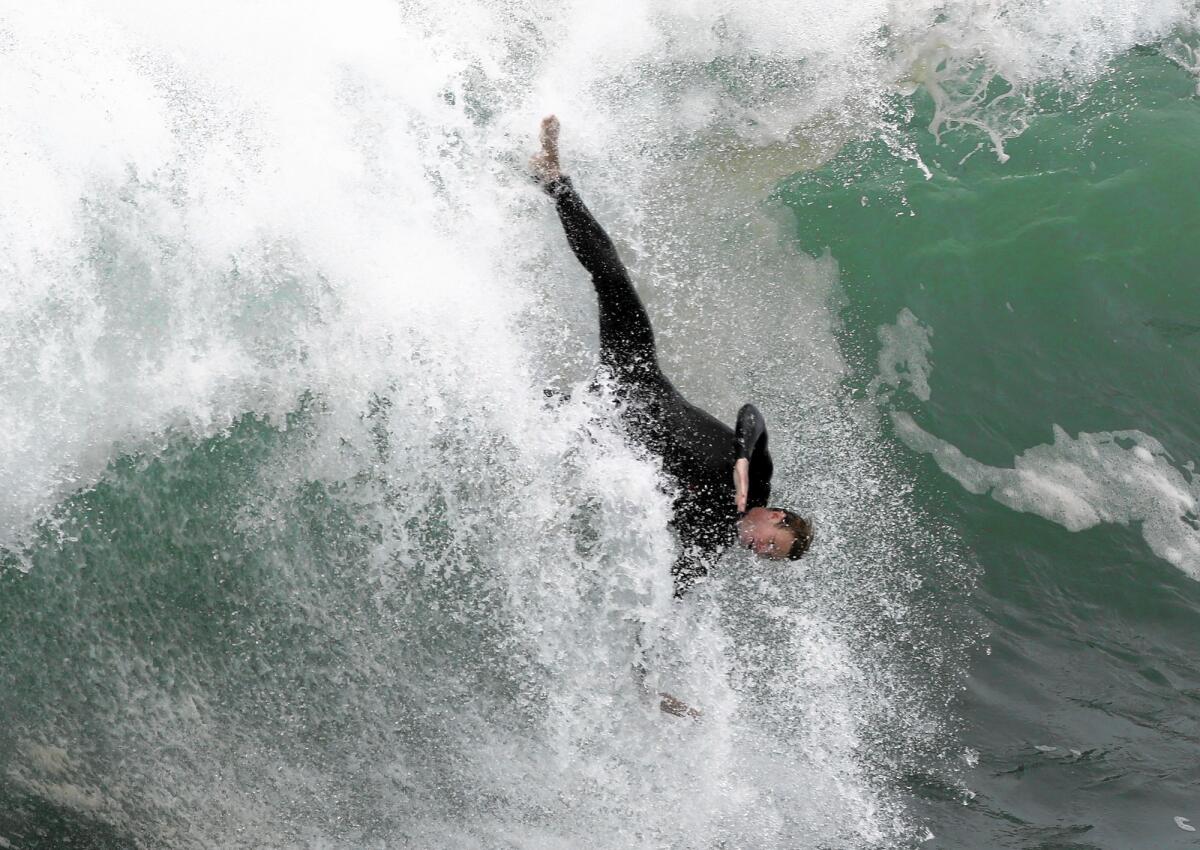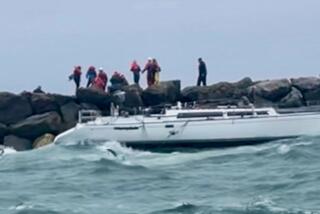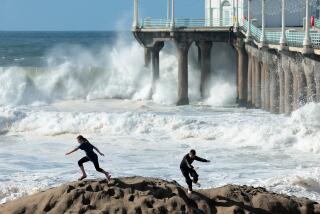California Journal: Surf culture’s inspiration transcends the wave

The waves were massive in Newport Beach this week, pushed to shore by a swell that originated on the other side of the world, somewhere in the Southern Hemisphere.
Over a four-day period here, lifeguards rescued 24 people, six of them hapless souls caught in the giant surf at the Wedge, an infamous break at the tip of the Balboa Peninsula known not just for the heft and odd triangular shape of its waves, but for the ferocious way they slam against the sand.
“You can really kill yourself,” said Jill Bonner, 63, who stood on the shore behind yellow caution tape that held back dozens of spectators. “I get nervous watching.”
Her photographer husband, Gary Steinberg, 65, trained a long lens on bodysurfers crashing around in the churning water. “Every year,” he said, “someone breaks their neck here.”
On Tuesday, the last day of big surf, a yellow flag with a solid black circle fluttered from the Wedge’s lifeguard tower. When the flag is up, no flotation devices like surfboards or boogie boards are permitted. The waves are for bodysurfers only. But this breed is nothing if not inventive.
Chance King, a 22-year-old from Hawaii’s North Shore, emerged from the water carrying a brown plastic cafeteria tray. “You use it kind of like a body board,” he said, “and once you catch enough speed, the board keeps you above the water. It’s not a flotation device because if you let go, it sinks.”
Nearby, Gar Myers, white-haired and 47, sat on a rock, dripping wet, tired but abuzz with adrenaline after 30 minutes in the water. “I’m out of gas,” he said. “I almost drowned yesterday. I had a mini-stroke on my fourth wave. I went numb here,” he said, pointing to the right side of his face. “My arm went numb. And I go, ‘Not now! More waves are coming!’”
After two hours in the water, Cole Fitzgerald, 19, had come ashore because he was thirsty. But he planned to go right back in. “Dude,” his friend said, “if you die out there they’re not coming to rescue you.”
::
I don’t surf, and don’t pretend to understand the lure of free falling down the face of a 15-foot wave only to hit the sand hard enough to dislocate a shoulder or break a bone.
But you don’t have to be a surfer to identify with surf culture. For many of us, surfing is an aspirational thing – Maybe I’ll learn to do that one day, we think, but in the meantime, I think I’ll just sit on the beach in my Quiksilver rash guard and watch.
Living at Venice Beach, I feel a sense of neighborhood pride when I see a kid on a bicycle riding toward the beach, holding a board under one arm. I love nothing more than standing on the Venice Pier and eavesdropping on surfers in the water below as they talk smack to one another. I love surfing! I just don’t want to surf.
The first people to embody that paradox, I’d venture, were the Beach Boys, who perhaps had more to do with burnishing the Southern California surfing mystique than any non-surfers in history. (Just one of the group’s five founding members surfed.)
There is, of course, a dark side to the sport — the age-old, testosterone-fueled localism that leads regularly to fights over who “owns” the waves at a particular beach.
Steve Grambo, 55, who told me he’d spent 24 years in the Marines, considers himself a local at the beaches from Manhattan Beach to the Wedge. He said he’s seen plenty of anti-social surfing behavior.
A year and a half ago, Grambo said, a 23-year-old surfer in Palos Verdes, which is notorious for its aggressive locals, pulled a Glock on him and announced “Locals only.”
“I told him, ‘I grew up here. You need to leave,’” Grambo said before disarming the surfer and calling the cops.
Was this a tall tale? I don’t know, but it sounded plausible. Fifteen years ago, Australian surfer Nat Young, who had been both an aggressor and a victim during his long career, compiled an anthology of essays about violent altercations between surfers. He called it “Surf Rage.”
“Waves are seen as a limited resource,” explained Cassie Comley, a 28-year-old surfer and University of Oregon sociology doctoral student who has written about the paradoxical abundance of male aggression in a sport so often described as Zen-like. “It’s not like snowboarding, where you know the mountain is always going to be there. The waves can be good for a week and then flat for a month.”
She said she’d noticed that men were markedly less aggressive in the water when women were present. Women are still woefully underrepresented on the waves. I saw no women in the water at the Wedge.
Nor, fortunately, was any obnoxious territoriality on display. “I can’t say we have a ton of it here,” said Newport Beach Chief Lifeguard Rob Williams. “We call the Police Department very rarely.” (He did summon police on Monday, he said, when some knuckleheads on surfboards refused to honor the black ball flag and stayed in the water.)
Williams also challenged the idea that a lifeguard would not intervene to save an imperiled surfer. Last July, he noted, veteran Newport Beach lifeguard Ben Carlson, a big-wave surfer, drowned while trying to rescue a swimmer in high surf.
“If someone needs assistance,” Williams said, “we’re going in.”
As I sat on the sand watching surfers paddle past a terrifying impact zone into waves as big as buildings, I felt perfectly content to be part of the scene without even getting wet. I fantasized about the day, never to come, when I would be out there with them. And, you know, it felt pretty good.
Twitter: @AbcarianLAT
More to Read
Start your day right
Sign up for Essential California for news, features and recommendations from the L.A. Times and beyond in your inbox six days a week.
You may occasionally receive promotional content from the Los Angeles Times.







